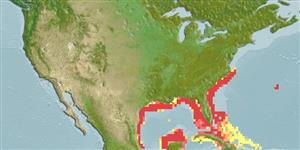Common names from other countries
Environment: milieu / climate zone / depth range / distribution range
Ecología
marino demersal; rango de profundidad 19 - 130 m (Ref. 26938). Subtropical; 37°N - 7°N, 98°W - 59°W
Western Atlantic: North Carolina to southern Florida, USA, northern Bahamas, Gulf of Mexico, Caribbean Sea, Colombia to Trinidad and Tobago.
Tamaño / Peso / Age
Maturity: Lm ? range ? - ? cm
Max length : 71.0 cm TL macho / no sexado; (Ref. 26938); common length : 35.0 cm TL macho / no sexado; (Ref. 3275); peso máximo publicado: 2.8 kg (Ref. 40637)
Occurs in bays, lagoons and shallow coastal waters (Ref. 7251). Inhabits mainly hard and sandy bottoms (Ref. 3275).
Life cycle and mating behavior
Maturities | Reproducción | Spawnings | Egg(s) | Fecundities | Larva
Distinct pairing (Ref. 205).
Robins, C.R. and G.C. Ray, 1986. A field guide to Atlantic coast fishes of North America. Houghton Mifflin Company, Boston, U.S.A. 354 p. (Ref. 7251)
IUCN Red List Status (Ref. 130435)
CITES (Ref. 128078)
Not Evaluated
Threat to humans
Harmless
Human uses
Pesquerías: escaso valor comercial
Herramientas
Special reports
Download XML
Fuentes de Internet
Estimates based on models
Preferred temperature (Ref.
115969): 21.1 - 27.5, mean 24.2 (based on 84 cells).
Phylogenetic diversity index (Ref.
82804): PD
50 = 0.5000 [Uniqueness, from 0.5 = low to 2.0 = high].
Bayesian length-weight: a=0.00646 (0.00290 - 0.01435), b=3.17 (2.99 - 3.35), in cm Total Length, based on LWR estimates for this Genus-body shape (Ref.
93245).
Nivel trófico (Ref.
69278): 4.3 ±0.6 se; based on size and trophs of closest relatives
Resiliencia (Ref.
120179): Medio, población duplicada en un tiempo mínimo de 1.4-4.4 años (Preliminary K or Fecundity.).
Fishing Vulnerability (Ref.
59153): Moderate to high vulnerability (48 of 100).
